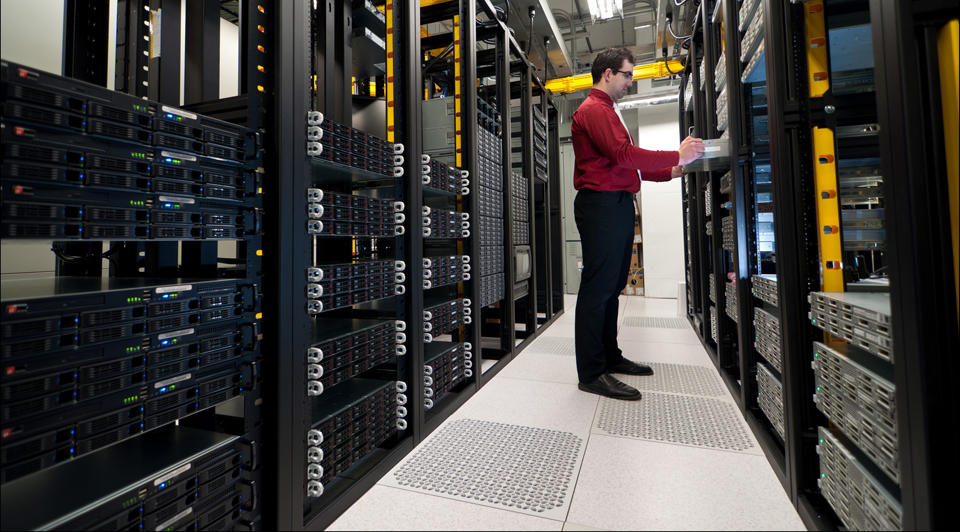Reasons you may be experiencing issues with your Data Center Floor

Are You Experiencing Issues With Your Data Center Floor?
Data center floors are a mainstay of data centers all over the world. Their innovative raised design provides a wide range of benefits specific to data centers. That said, they aren’t immune to issues down the line. These floors have precise requirements for use and maintenance and critical load specifications to meet. If your data center floor is experiencing issues, we can help. Let’s take a closer look at data center flooring and the problems that may occur with them.
Why Do Data Centers Have Raised Floors?
Raised floors are an essential part of data centers for many reasons. The primary benefit comes from their impact on airflow and wire arrangements.
The raised floor is comprised of a pedestal and head system that allows the tiles, either perforated or solid, to make up the data center floor. The subfloor of the raised floor system allows necessary cables and structural components to be housed under the floor and still allow for proper air flow for efficient cooling of data center equipment.
Specifications for Data Center Raised Floors
While their benefits are numerous, data center floors also come with a long list of specifications that are critical for a long life span and appropriate performance.
The tiles that make up the raised floor must be completely flat. They have adjustable heights so you can find the right level, but they need to be flat for proper weight distribution. They will also need to be positioned so that any tiles in front of cabinets still have all four sides visible. This layout helps to distribute weight and ensures that workers can lift the tiles up and access the cables easily when need be.
Aside from placement, tiles also need to be physically strong enough to support the weight of several thousand pounds of equipment within your electronics cabinets. For this reason, they are usually made of materials like aluminum and steel.
At DataSpan, we use steel or concrete-filled tiles with exterior steel finishes to support heavy equipment weights. We’ll go over the specifics of weight in the next section, as these are a significant part of raised floor data center standards. Appropriate weight specifications can be a key component of early wear or damage to raised floor tiles.
Cabinets also need to be carefully arranged to keep weight distribution even and avoid impeding airflow or cable access. They shouldn’t be placed at an angle. Instead, they should always be placed in aisles parallel to the tiles.
Finally, maintenance is a critical component of keeping a raised floor in good condition. A raised floor typically lasts about 20 years with regular inspections and repairs as needed. You may want to consider strengthening and leveling your floors, too. You should also be sure to use anti-static cleaning supplies.
How Much Weight Can a Raised Floor Support?
Answering this question accurately is critical for the continued success of a raised floor and preventing costly damage. Data center floor loading standards include many data points and types of information about your floor’s materials, the structures that will be moving across it, and your maintenance practices. Heavier loads can cause data center floors to collapse. Because cabinets in a data center can weigh 2,800 to 3,000 pounds you’ll need to answer the following questions:
- Have the floor tiles been modified to handle greater weights?
- What is the weight load rating of your Raised Access Floor (RAF) System?
- Have the pathway and subfloor of the data center been assessed to determine if the pedestal can support the weight moving across the floor?
- Does your RAF system have the required rolling load rating for the egress and ingress of the equipment that you are moving?
DataSpan’s experts can help ensure the data center floor can handle increased loads.
The Advantages of Raised Floors in Data Centers
Raised floors offer a range of other benefits, including:
- Improved airflow: Raised floors offer efficient cool air delivery beneath the equipment.
- Cable management: With fewer surface-level cables, you can reduce trip hazards, improve appearances and consolidate the need for hardware and ports.
- Design flexibility: The floor tiles are modular. As a result, you can easily arrange them to fit new orientations, including hot and cold aisles.
- Easy access: Simply lift a tile for easy access to the cables underneath.
- Strong grounding: Since the pedestals attach to the ground of the building, they can offer the needed ground for the equipment.
- Low maintenance costs: If some of the tiles start to wear, you can simply replace them as needed instead of swapping out the whole floor.
- Reduced energy consumption: Efficient airflow setups can bring cooled air up to the front of the cabinets so less energy is needed to keep the temperature within the ideal range.
Common Challenges With Raised Floors
While server room raised floors are an excellent way to support your operations neatly and efficiently, there are a few issues to be aware of before you install one. You’ll need to thoroughly meet data center floor loading standards. You should also schedule professional maintenance and regular cleanings to keep your floor in top condition.
Some issues that can appear in data center floors include:
- Structural problems: With misuse or improper maintenance practices, a raised floor can weaken or collapse. Panels may warp due to repeated heavy rolling loads or moisture in wood-cored panels. Edge trim can go missing due to abuse, instability or improper reinstallation after removal. Without edge trim, you might see premature wear, instability, chipping and other issues. Lateral instability can come from many sources, such as abuse, poor installation, loose braces and temperature changes. Always stay on top of structural issues with appropriate, professional care and maintenance.
- Age: Raised floors typically last for about 20 years. If yours is at that age, you may see some issues related to the simple factor of a floor’s life span.
- Low energy efficiency: If used correctly, raised floors can be a great benefit to your energy consumption. Without proper installation, though, they can actually be less efficient.
The best way to avoid these issues is to work with professionals. DataSpan offers professional installation, repair, maintenance and replacement of data center floors. These trusted services can help you maximize your floor’s life span and keep it working well for years to come.
DataSpan’s Data Center Floor Services
The raised access floor (RAF) system is one of the critical components of a data center. The pros at DataSpan offer a wide range of data center raised floor services:
- We can do assessments identifying potential issues.
- DataSpan can perform live-access floor replacements with higher capacity tiles.
- By carefully lifting the equipment, we can replace your floor without disrupting regular operations.
- DataSpan can repair damaged pedestals and heads to reinforce the floor.
DataSpan has been helping data centers optimize their operations since 1974. We work as an extension of your team and focus on meeting the unique needs of your organization, from energy-efficient server room floors to cost-effective repairs. To learn more, contact us today.

About the Author: Alex von Hassler’s long term focus is the continued testing, learning, and deployment of modern IT solutions. During his years as a DataSpan team member, his responsibilities grew from managing Salesforce CRM to improving system security, creating marketing initiatives, as well as providing continued support to the highly motivated and experienced team in an ever-changing industry. As DataSpan evolves to provide the best-fitting IT solutions to its customers, Alex von Hassler continues to hone his skills in the world of web-based ERP systems, security, and best customer engagement practices. Empowering such a dynamic team with the right tools provides him with enormous gratification.







